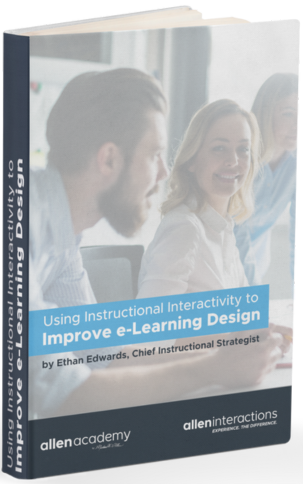Strategy
Make the most of your investment in your training department
Investing in the development of a robust and effective eLearning ecosystem is important for most organizations, regardless of size or industry. Unfortunately, without the right strategy in place, such investments are likely to fall short of their targets.
Comprehensive Strategy Consulting
For more than 20 years, Allen Interactions has helped organizations in a wide range of industries create comprehensive and cohesive learning strategies.
Our strategic consulting services include:
- Behavior Catalog™ creation
- Behavioral modification
- Performance evaluation
- Curriculum analysis
- Instructional strategy development
- Learning technology audits
- Staff augmentation
Get started today
To get the process started, we offer a 1-day on-site workshop and preliminary training strategy audit. During the workshop, our experts will run you through some key steps to optimize your approach to elearning.
Developing a learning strategy for your organization starts with 3 key steps:
Data Gathering
Information is the foundation of any strategic planning exercise. Our experts will help you conduct a comprehensive data gathering exercise to capture the current state of your primary business activities and processes, critical behaviors, available instruction and development materials, and identify your key performance indicators.
Deep Discovery
With foundational data in hand, we’ll guide you through a deep discovery to map your enterprise processes, ,and desired performance. We’ll also help you map your current learning strategic vision and initiatives.
Cataloging & Prioritization
The final step in the workshop is to catalog the behaviors that are most important to business performance success, the technology available in your elearning ecosystem, and your existing curriculum. We’ll use these data to prioritize your strategic initiatives.
The awesomely effective CCAF design model can be applied to any instructional design project, regardless of industry or end goal.

Download Our Improve eLearning Design eBook
Using Instructional Interactivity to Improve eLearning Instructional Design
In this e-Book, Ethan Edwards covers the concept of instructional interactivity, and demonstrates how it can transform the e-learning experience for employees and learners working independently through an e-learning program.
Gain understanding of the four essential components of instructional interactivity for engaging e-learning instructional design in the CCAF Design Model: Context, Challenge, Activity & Feedback.
Featured Case Study

Nexstar Case Study
Closing Technician Skills Gaps with Interactive eLearning
Nexstar needed to build competency and skills for residential service technicians across three trade fields – plumbing, electrical, and HVAC.
Together, Allen Interactions and Nexstar identified skill gaps in the plumbing, electrical, and HVAC trades. Nexstar’s distributed technician audience needed eLearning and skill reinforcement through on-the-job training and assessments by training leaders in the field. The custom eLearning solution is engaging, realistic, filled with real-life situations and environments to prepare technicians for their trade, regardless of experience.
After trusting Allen Interactions with their training needs, the company experienced the following solution highlights:
Plumbing, electrical, and HVAC residential home service providers reported overall time to complete was reduced.
The value of learning was immediate and measurable for each learner, with motivation and completion rates towards licensure increasing significantly.
The eLearning solution closed skill gaps by focusing on areas of common mistakes, rare contexts, and application of critical knowledge.
